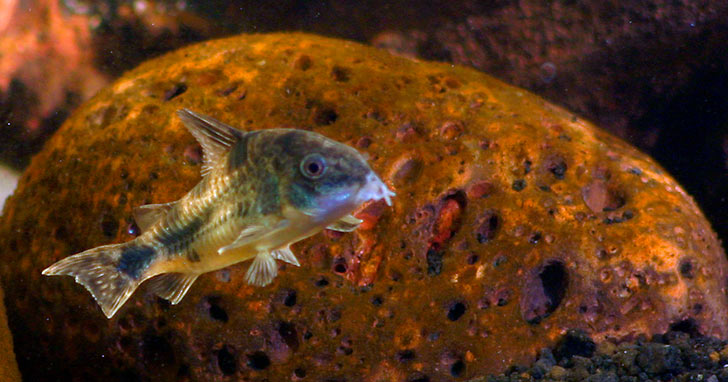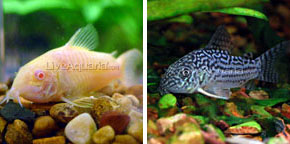Corydoras Catfish: Freshwater Cleanup Crew
 What makes corydoras so popular? Known for their peaceful and entertaining nature, corydoras catfish are favored among both beginning and advanced aquarists. But these energetic bottom dwellers are also workhorses when it comes to cleaning uneaten fish food from aquarium substrate, which helps to maintain water quality. In fact, corydoras are truly "community" fish whose actions benefit every inhabitant of almost every freshwater community aquarium. The Corydoras Advantage Corydoras are also known as Corys or Cory Cats. Unlike many types of catfish, Corys remain relatively small as adults. In fact, most only grow to between 1" and just over 4" in length, which suits them to smaller freshwater community aquariums. However, since most Cory Cats prefer to be kept in groups of four or more, these active scavengers also attend to the substrate cleaning needs of larger aquatic systems. In addition to their smaller size, most species of Corydoras are active during daylight hours. This allows aquarists ample time to observe their antics, in comparison to the nocturnal habits of most types of catfish. Plus, there are over 140 identified Corydoras species, each in an array of body shapes and colorations, which ensures there is a Cory Cat suited to any aquarium's style. Corydoras in the Home Aquarium Cory Cats are members of the armored catfish family. Different Corydoras species are found across South America. In the wild, Corys are generally found in smaller streams, at the edges of rivers, and in marshes and ponds. Most species are native to slow-moving, shallow, and clear water and forage amongst sand, gravel, and detritus for insect larvae, worms, vegetable matter, and other food. In the home aquarium, Cory Cats are fairly adaptable to a wide range of water conditions; however, most do best in systems with neutral pH and moderate water hardness. Like other fish, Corys do not handle fluctuations in water parameters well. Since they forage the aquarium substrate for food with their sensory barbels, they prefer soft sand substrates or rounder gravel. Though they scavenge the substrate for uneaten fish food that has fallen there, Corys shouldn’t be limited to a diet of leftovers. Most relish sinking pellets, flakes, and live or frozen foods as their main diet. Some Corys will also dart to the surface to eat flake foods. In fact, one of the most enjoyable antics to observe is a school of Cory Cats darting to the water surface one after another. Breeding adults spawn their eggs on aquarium glass, driftwood, or amongst stalks of plants. In most species, males are slightly slimmer than females, especially when viewed from above. The Corydoras Cleanup Crew There are two main benefits for employing Corydoras catfish to help clean your aquarium substrate and therefore maintain water quality. First, because of their smaller size, Cory Cats are able to scavenge amongst plant stalks, reach into corners, and consume uneaten food from smaller spaces in which other, larger, scavengers might miss. Secondly, many species of Corydoras are active during the day. This means they are feeding when other tankmates are feeding. Therefore, they oftentimes consume uneaten food that has fallen to the substrate before it begins to break down and contribute to potentially toxic ammonia levels in the aquarium water.
|
||
|
|





